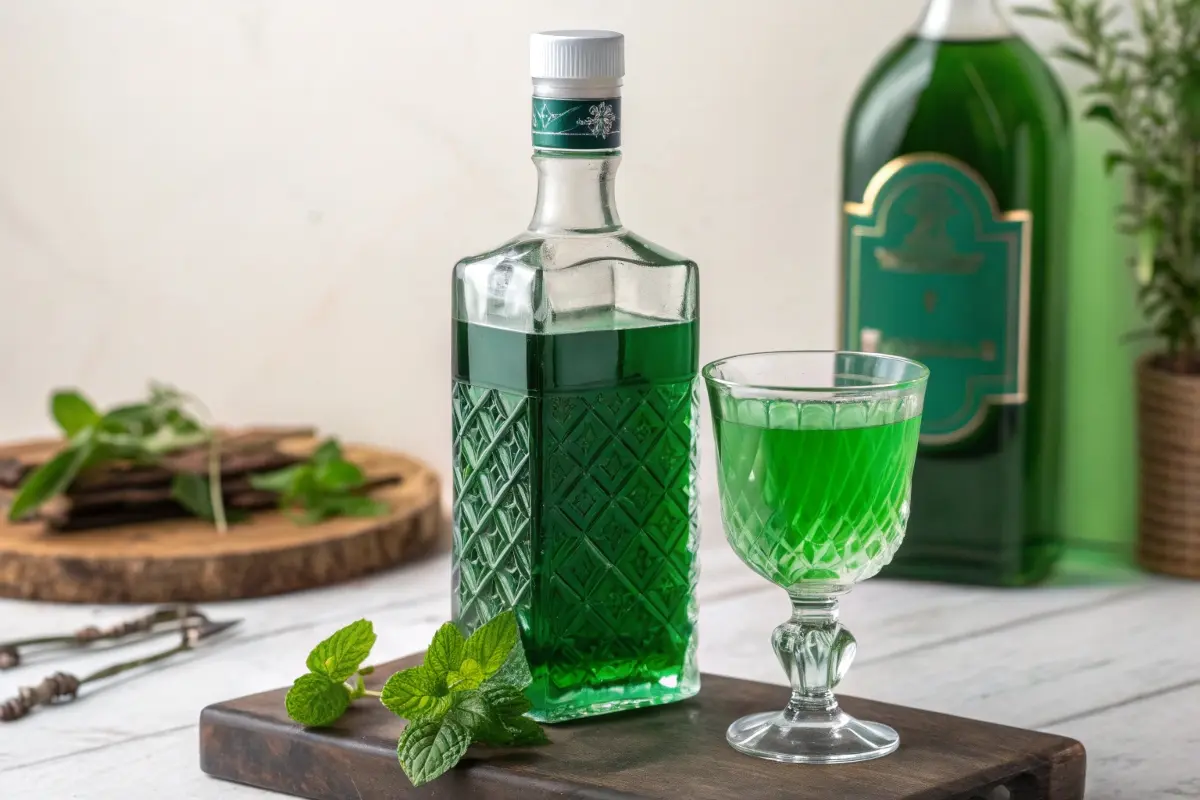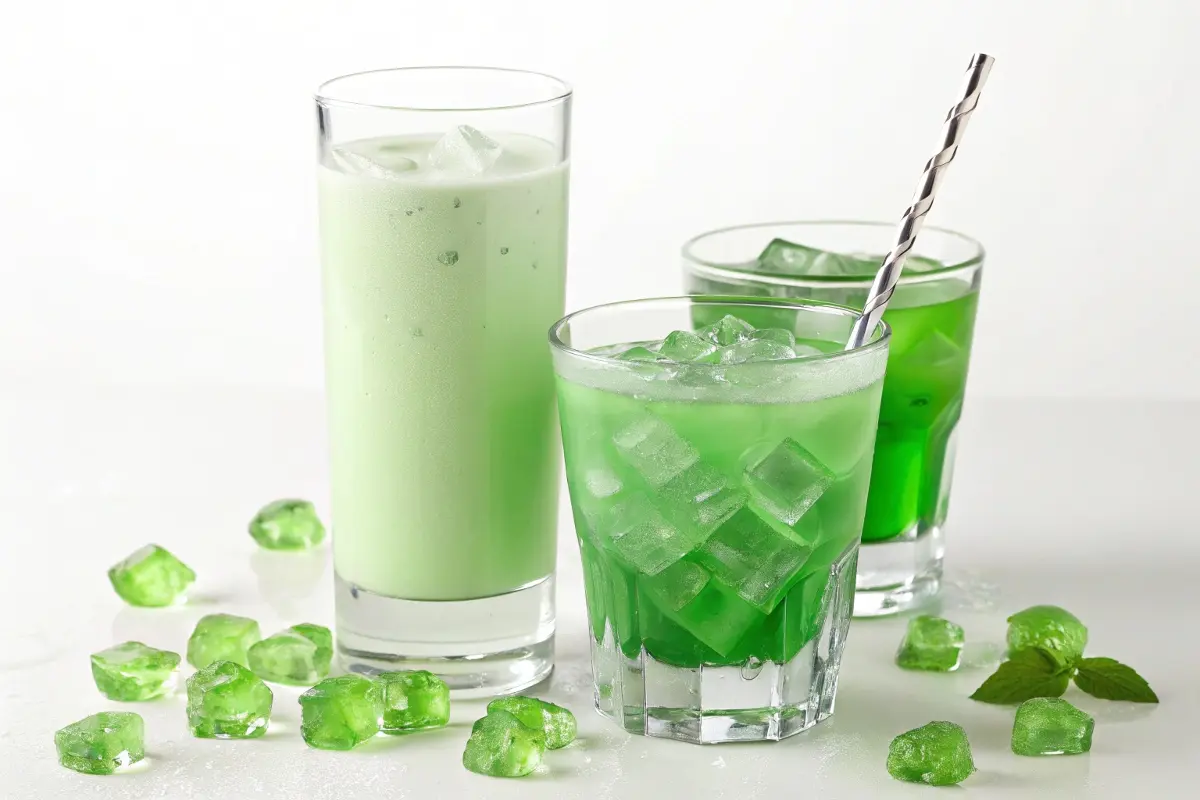Crème de menthe is one of those drinks that feels as refined as its name suggests. With its minty flavor and smooth texture, this liqueur has charmed drinkers and chefs alike for generations. But what’s behind the name? Why does it sound so fancy? Let’s take a journey into the story of this classic mint-flavored spirit and uncover the secrets of its name, origin, and uses.

Introduction to Crème de Menthe
This beloved liqueur is much more than just a drink. With its vibrant green hue and refreshing taste, it has become a staple in both cocktail culture and the culinary world. But there’s also a fascinating story behind its creation and how it got its iconic name.
Whether you’re enjoying it in a sophisticated cocktail or a rich dessert, this liqueur brings a little French flair to every sip and bite.
The Origins of Crème de Menthe
Historical Background of the Name
The French translation of “crème de menthe” means “cream of mint,” though it’s not made with cream. The term “crème” refers to the syrupy texture of the liqueur rather than any dairy content. Created in 19th-century France, it quickly became a favorite among those who enjoyed sweet, flavored spirits.
The Role of French Influence
France has a knack for making everything sound elegant, and this drink is no exception. From its name to its production methods, everything about it feels quintessentially French. During the 19th century, flavored spirits were all the rage, and this mint-based creation stood out for its refreshing taste and luxurious feel.
What Is Crème de Menthe?
Definition and Ingredients
This sweet, mint-flavored liqueur is available in two forms: green and clear. Both versions have the same flavor, but the green variety often includes added color for visual appeal.
Here’s a breakdown of its ingredients:
| Ingredient | Quantity |
|---|---|
| Fresh Mint Leaves | 1 cup |
| Vodka | 1 ½ cups |
| Sugar | 1 cup |
| Water | 1 cup |
| Food Coloring (Optional) | A few drops |
How It’s Made
The process involves steeping mint leaves in vodka to extract their flavor. The infused liquid is then sweetened with a sugar syrup and, optionally, dyed green. This simple yet effective recipe has made it a staple for home mixologists and distilleries alike.
Why Is It Called Crème?
The Linguistic Meaning of “Crème”
In French, the term “crème” doesn’t always imply dairy. Instead, it often refers to something rich, smooth, or luxurious. In this case, it highlights the velvety consistency of the drink.
The Connection to Texture and Flavor
The silky texture of this liqueur sets it apart. Its rich consistency enhances its sweet and minty taste, making it a true indulgence for the senses.
“It’s like liquid velvet—smooth, rich, and undeniably indulgent.”

The Evolution of the Name
How Its Name Influenced Marketing
The sophisticated French name helped position this drink as a premium product. When it hit the international market, the elegant branding appealed to a sense of refinement, helping it stand out from other spirits.
Variations in Different Cultures
While the name has stayed consistent, different regions have adapted the recipe to suit local tastes. Some versions are sweeter, while others emphasize herbal notes.
Popular Uses
In Cocktails
This liqueur shines in cocktails, adding a minty twist to classic recipes. A couple of standout drinks include:
- Grasshopper: A creamy blend of crème de menthe, crème de cacao, and cream.
- Stinger: A simple mix of this liqueur and brandy, perfect for sipping.
In Desserts
It’s also a fantastic ingredient for desserts. Think mint chocolate brownies, cheesecake, or even a drizzle over ice cream.
Common Problems with Crème de Menthe
Misconceptions About Its Name
One of the most common misunderstandings surrounding this liqueur is the assumption that it contains actual cream. The term “crème” in French refers to the smooth, velvety texture of the drink rather than any dairy content. This misconception can lead to hesitation, especially among individuals with dietary restrictions or those who might avoid dairy products. The truth? It’s entirely cream-free, and its luxurious texture comes from its sugar content and careful production process.
Because of this misunderstanding, some might pass it over, missing out on its refreshing minty charm. If you’ve ever skipped it for fear of dairy, rest assured it’s a sweet, indulgent treat that’s as versatile as it is delightful.
Confusion With Similar Liqueurs
Crème de menthe often finds itself lumped together with other mint-flavored spirits, especially peppermint schnapps. While both share a minty profile, they are distinctly different in flavor, sweetness, and intended use.
- Peppermint Schnapps: Known for its robust mint intensity, schnapps packs a punch with higher alcohol content and a less sweet profile. It’s often favored in winter cocktails or as a fiery shot.
- Crème de Menthe: Delicate, syrupy, and sweet, this liqueur is perfect for enhancing desserts, crafting balanced cocktails, or sipping on its own.
Confusion between these two can lead to unexpected results in recipes. For instance, substituting schnapps for crème de menthe in a dessert can overwhelm the dish with strong alcohol notes, while using crème de menthe in place of schnapps might not deliver the same punch in a bold cocktail. Understanding the unique qualities of each ensures you’ll always use the right mint spirit for your needs.
By clearing up these misconceptions, you can fully embrace crème de menthe as the sweet, minty treasure it is, perfect for a wide variety of culinary and beverage applications.
Solutions to Common Crème de Menthe Issues
Educating Consumers About the Name
The best way to clear up misunderstandings is through education. Sharing the story behind crème de menthe’s name and ingredients helps demystify the liqueur and makes it more approachable.
Differentiating Crème de Menthe From Others
Clear labeling and marketing that emphasizes crème de menthe’s unique qualities can help it stand out. Highlighting its French origins and versatile uses can also draw attention to what makes it special.
Recipe: How to Make Crème de Menthe at Home
Creating your own crème de menthe is easier than you might think. Here’s a simple recipe to try:
Ingredients
- 1 cup fresh mint leaves
- 1 ½ cups vodka
- 1 cup sugar
- 1 cup water
- A few drops of green food coloring (optional)
Preparation Method
- Infuse the Vodka: Add the mint leaves to a jar and pour the vodka over them. Seal the jar and let it sit for 5-7 days, shaking it gently every day.
- Make the Syrup: In a saucepan, combine sugar and water. Heat until the sugar dissolves completely, then let it cool.
- Strain and Combine: Strain the mint-infused vodka and mix it with the syrup. Add food coloring if desired.
- Bottle It: Pour the liqueur into a clean bottle, seal it, and store it in a cool, dark place. Enjoy it in cocktails or desserts!
Fun Facts About Crème de Menthe
Famous Cocktails Featuring Crème de Menthe
Did you know that crème de menthe played a role in popularizing dessert cocktails? The Grasshopper, invented in the 1910s, owes its creamy, minty flavor to this liqueur.
Unique Recipes Around the World
In Italy, crème de menthe is often used in gelato recipes, while in the U.S., it’s a favorite for making festive holiday treats like mint fudge.
The Cultural Significance of Crème de Menthe
Its Role in French Cuisine
In France, crème de menthe is cherished not only as a drink but as a symbol of refined taste. It often appears in French recipes, adding a touch of sophistication to dishes and desserts.
Influence on Global Gastronomy
From Asia to the Americas, crème de menthe has left its mark on global gastronomy. Its ability to elevate both cocktails and culinary creations has made it a staple in kitchens and bars worldwide.
The Legacy of Crème de Menthe
Why the Name Still Matters Today
Crème de menthe’s name is more than just a label—it’s a testament to its rich history and timeless appeal. Its combination of smoothness and minty freshness continues to capture hearts and palates across generations.
Final Thoughts on Crème de Menthe
Whether you enjoy it in a classic cocktail, drizzle it over ice cream, or marvel at its French origins, crème de menthe is a reminder that sometimes, the most delightful things come with a story worth savoring.
“Minty, smooth, and steeped in tradition—that’s crème de menthe, a liqueur that never goes out of style.”
FAQs
Can you drink this minty liqueur straight?
Yes! It’s delightful on its own, especially when served chilled or over ice. Many enjoy it as a post-dinner treat.
Do people sip mint-flavored liqueurs?
Absolutely. The sweet and refreshing flavor makes it an excellent choice for sipping at a leisurely pace.
What’s the difference between green and clear varieties?
The green version is colored for aesthetic appeal, while the clear version is natural. Both have the same flavor profile and can be used interchangeably.
Can this liqueur be used in baking?
Yes! Its minty flavor pairs wonderfully with chocolate and is perfect for cakes, brownies, and frostings.
What’s a good substitute for this mint drink?
Peppermint syrup or extract works well in most recipes, especially for non-alcoholic needs.
Can you drink crème de menthe straight?
Yes, you can absolutely drink crème de menthe straight. Its sweet, minty flavor makes it a delightful choice as a digestif after meals. Serve it chilled or over ice for a refreshing finish to your evening.
Do people sip crème de menthe?
They certainly do! Crème de menthe is often sipped slowly because of its sweetness. Whether enjoyed neat, on the rocks, or as part of a fancy cocktail, it’s a drink meant to be savored.
What is crème de menthe good for?
Crème de menthe is incredibly versatile. It’s a key ingredient in classic cocktails like the Grasshopper and the Stinger. It’s also perfect for desserts, adding a minty touch to recipes like brownies, cheesecakes, or ice cream. During the holidays, it’s a popular choice for creating festive mint-flavored treats like fudge and truffles.

